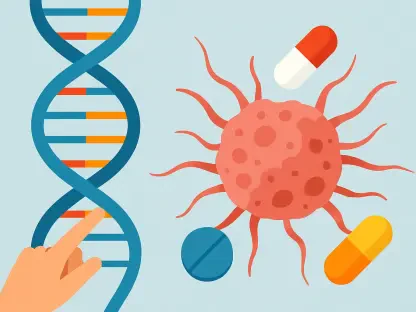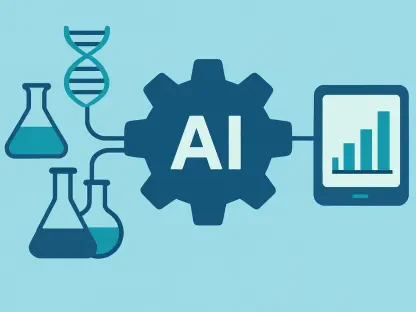Ovarian cancer remains a formidable challenge in the medical community due to its elusive nature and high fatality rate. With approximately 75% of cases detected at later stages, patients often face dire prognoses. Current diagnostic methods are largely insufficient, typically identifying the disease when it has already progressed significantly. This report explores the role of genetic insights, which have emerged as a potential game-changer in early detection, through recent advances in genetic research and technology.
Current Landscape of Ovarian Cancer Detection
Ovarian cancer detection faces significant hurdles, primarily due to its frequent late diagnosis and consequent high mortality rate. Most patients are diagnosed when the disease has advanced to stages 3 or 4, complicating treatment efforts and reducing survival prospects. Key technologies that currently underpin diagnosis involve imaging and symptom analysis, which often fall short in identifying the cancer at a treatable stage.
Despite the employment of these technologies, they present notable limitations. Existing methods predominantly focus on visible symptoms or ultrasound imaging, which are inherently retrospective rather than predictive. Consequently, the incorporation of genetic insights is being closely evaluated as it holds promise for diagnosing the disease at its inception. This advancement could fundamentally change how ovarian cancer is approached, emphasizing prevention over late treatment.
The Power of Genetic Insights
Understanding Genetic Mutations and Risk Factors
Genetic mutations such as BRCA2 and TP53 have been identified as significant markers in hereditary cancer syndromes, underscoring their importance in ovarian cancer detection. Individuals carrying these mutations face elevated risks for developing not only ovarian cancer but other types as well. In hereditary breast and ovarian cancer syndrome and Li-Fraumeni syndrome, these genetic markers offer crucial clues about predisposition and risk, potentially guiding preventive measures.
These findings establish the basis for integrating genetic testing into standard practice, allowing for early identification of at-risk individuals. This proactive approach could lead to preventive interventions tailored to individual genetic compositions, fostering a paradigm shift from reactive treatment to proactive prevention.
Technological Advancements in Genetic Research
Technological innovations such as single-cell RNA sequencing are pivotal in unveiling early cellular changes within at-risk populations. This technique allows researchers to capture snapshots of genetic and cellular behavior at an unprecedented resolution, facilitating the identification of genetic predispositions before the manifestation of overt symptoms. Although in its nascent stages, this technology promises transformative insights for early detection.
Such innovations are complemented by the development of organoids, which are miniature cultured forms of tissues derived from patient cells. By studying these organoid models, researchers can closely observe the cellular dynamics that underlie cancer development. This approach enables a deeper understanding of the nuances of genetic predispositions and mutations, paving the way for more precise detection methods rooted in genetic markers.
Challenges and Limitations
Genetic research, despite its potential, comes with inherent challenges, such as the complexity of analyzing vast genetic data sets. The variations in genetic expressions present another layer of difficulty in forming consistent detection strategies. Researchers must untangle these variations to predict which genetic patterns correlate with heightened risk effectively.
Moreover, ethical considerations concerning genetic testing and data privacy cannot be understated. With advancements in genetic technology, privacy concerns surrounding sensitive genetic information call for careful governance to protect individuals’ rights. These ethical challenges demand robust solutions, including regulatory oversight and transparent ethical protocols.
Regulatory and Compliance Considerations
The landscape of genetic research is bound by stringent regulations that ensure ethical compliance and data protection. Laws such as the Genetic Information Nondiscrimination Act offer foundational guidelines, influencing the methodologies adopted in research studies. These regulations underscore the necessity for ethical considerations in handling genetic information.
The adherence to these standards is imperative not only for legal compliance but also to maintain public trust and support for genetic research. Ensuring ethical practices in data handling and patient consent fortifies the credibility of ongoing and future research initiatives. It also reinforces the need for meticulous compliance with established guidelines that govern the conduct of genetic studies.
Future Directions in Ovarian Cancer Detection
The shift toward personalized medicine and precision oncology is gaining momentum, driven by the promise of tailoring treatments and preventive strategies to individual genetic profiles. Emerging trends in this domain highlight the importance of understanding genetic predispositions as a critical component in devising early detection tools. As technology and research evolve, there will likely be future disruptors that further refine these approaches.
As global economic and technological landscapes evolve, they impact the pace and direction of research. International collaboration in genetic research could accelerate progress, fostering global initiatives that leverage cutting-edge technologies for early detection. The synergistic advancement across these realms is poised to enhance the specificity and sensitivity of detection methodologies.
Conclusion and Recommendations
In summary, genetic insights hold the potential to revolutionize ovarian cancer detection by identifying at-risk individuals long before symptoms emerge. Future research should focus on expanding genetic studies to encompass diverse populations while refining technological methods for enhanced precision. Investment in genetic research, along with a commitment to ethical practices and data protection, is crucial.
Strategically incorporating genetic understanding into clinical care requires an interdisciplinary approach, blending technology, scientific insights, and patient-focused methodologies. By championing this integrative model, the medical community can expedite the transition from conceptive possibilities to actionable realities, ultimately improving patient outcomes and reducing the mortality associated with ovarian cancer.









